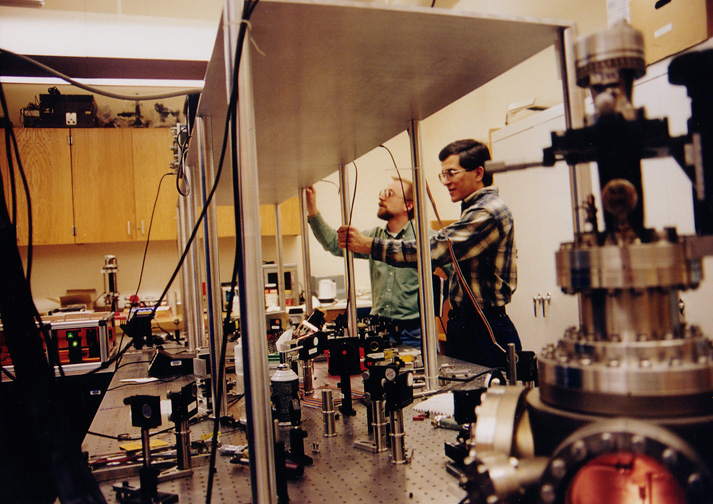Ultrafast Laser Spectroscopy
We have an in-house built Ti:sapphire laser capable of producing 17 fs, 2 nJ pulses at a repetition rate of 88 MHz. A compact rotating-mirror autocorrelator has been developed to measure the temporal width of the ultrafast laser pulses, see "A Compact Rotating-Mirror Autocorrelator Design for Femtosecond and Picosecond Laser Pulses," D. M. Riffe and A. J. Sabbah, Rev. Sci. Instrum. 69, 3099 (1998)
This laser has been used to study ultrafast
electron and phonon dynamics near the Si(100) surface. Publications in
this area include the following:
"Measurement
of Silicon Surface Recombination Velocity Using Ultrafast Pump-Probe
Reflectivity in the Near Infrared," A. J. Sabbah and D. M. Riffe, J. Appl.
Phys 88, 6954 (2000)
"Temperature
Dependence of Silicon Carrier Effective Masses with Application to Femtosecond
Reflectivity Measurements," D. M. Riffe, J. Opt. Soc. Am. B 19,
1092 (2002)
"Femtosecond
Pump-Probe Reflectivity Study of Silicon Carrier Dynamics," A. J. Sabbah
and D. M. Riffe, Phys. Rev. B 66, 165217 (2002).
"Coherent
Excitation of the Optic Phonon in Si: Transiently Stimulated Raman
Scattering with a Finite-Lifetime Electronic Excitation," D. M. Riffe and
A. J. Sabbbah, Phys. Rev. B 76, 085207 (2007).
We are currently studying LT-GaAs and InGaAs quantum-dot materials in order to identify the ultrafast relaxation mechanisms in these systems. These materials have a wide range of optoelectronics applications.
Other ultrafast reflectivity measurements have been made on Au, Ag, Al, W, and Ta samples. In Au we have used front-surface reflectivity measurements to probe the ballistic transport of hot holes away from the Au surface. Data from the other metals is currently being analyzed.

Professor Mark Riffe and graduate student Ali Sabbah make adjustments to an ultrafast dynamics experiment.
Heart of the Ti:sapphire laser. The Ti:sapphire crystal and two focusing mirrors are shown. The green light is from the laser that is used to pump the Ti:sapphire oscillator.

No, not a view from the ultrafast
lab, but the Grand Tetons, which are a mere 200 miles north of Utah State
University.





